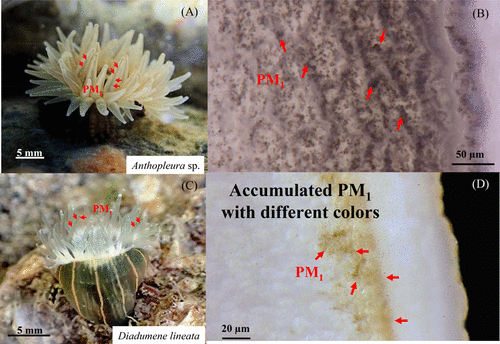当前位置:
X-MOL 学术
›
Environ. Sci. Technol.
›
论文详情
Our official English website, www.x-mol.net, welcomes your
feedback! (Note: you will need to create a separate account there.)
Evidence for Fossil Fuel PM1 Accumulation in Marine Biota.
Environmental Science & Technology ( IF 10.8 ) Pub Date : 2020-03-24 , DOI: 10.1021/acs.est.9b06976 Li-Lian Liu,Chen-Yun Hsieh,Meng-Ying Kuo,Chienhsun Chen,Yen-Hong Shau,Hon-Kit Lui,Chung-Shin Yuan,Chen-Tung Arthur Chen
Environmental Science & Technology ( IF 10.8 ) Pub Date : 2020-03-24 , DOI: 10.1021/acs.est.9b06976 Li-Lian Liu,Chen-Yun Hsieh,Meng-Ying Kuo,Chienhsun Chen,Yen-Hong Shau,Hon-Kit Lui,Chung-Shin Yuan,Chen-Tung Arthur Chen

|
When fine particulates such as those with a diameter of approximately 1 μm (particulate matter, PM1) are released from fossil fuel combustion into the air, they warm the atmosphere and contribute to millions of premature deaths in humans each year. Considerable quantities of PM1 eventually enter the oceans as suspended particulates, yet subsequent removal mechanisms are poorly understood. In fact, the presence of PM1 in marine biota has never been reported. Since sea anemones are opportunistic suspension feeders, they are anticipated to incorporate and accumulate PM1 in their bodies. By histological examination, PM1 was detected in 21 of the 22 sea anemones collected from Taiwan and Southeast China, with a depth of intertidal zone to 1000 m. PM1, if present, was always detected in endodermal layers and had the same dominant color (i.e., black, brown, or green) in different species from the same site. The bioaccumulation factor of PM1 in sea anemones was approximately 5–7 orders of magnitude. Based on radioisotope 14C results, the contribution of fossil fuel source PM1 was 8–24%. Regardless of PM1’s color, S and Fe were commonly detected by scanning electron microscopy and energy-dispersive spectrometry (SEM-EDS), suggesting anthropogenic sources. Furthermore, a maternal transfer of materials was suggested based on the existence of PM1 in sea anemone eggs and in brooding and released juveniles. The significance of PM1 accumulation by biota in aquatic ecosystems and the potential risk to living organisms via food webs warrant further investigation.
更新日期:2020-03-26











































 京公网安备 11010802027423号
京公网安备 11010802027423号